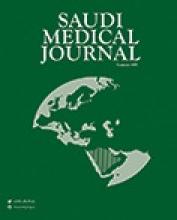Abstract
OBJECTIVE: Spinal muscular atrophy (SMA) is a common, often fatal, autosomal recessive disease leading to progressive muscle wasting and paralysis as a result of degeneration of anterior horn cells of the spinal cord. The prevalence of SMA cases in the Kingdom of Saudi Arabia (KSA) is much higher than the European and North American population. Deletions or mutations in 2 genes, telomeric form of the survival motor neuron (SMN1) and the neuronal apoptosis inhibitory protein (NAIP), are known to be associated with SMA. The aim of this study is to examine the deletions or interruptions of the SMN1 and NAIP genes in Saudi patients.
METHODS: The study included 121 Saudi SMA patients [type I (60 patients); type II (26 patients); and type III (35 patients)]. The deletions or interruptions of the SMN1 and NAIP genes were detected by using polymerase chain reaction. The study was carried out at the King Fahad National Guard Hospital, Riyadh, KSA between 2000 and 2002.
RESULTS: The homozygous deletions of exons 7 and 8 of the SMN1 gene were found in 94% and 87% of the patients. Exon 5 of the NAIP gene was deleted in 70%, but its deletion was more frequent in SMA type I (93%) as compared to type II (54%) and type III (43%). Seven patients with SMA diagnosis did not show any of the above homozygous deletions. All 230 control subjects had at least one copy of both SMN1 and NAIP genes, as expected.
CONCLUSION: Our results demonstrate that the deletion rate (94%) of the SMN1 gene in Saudi SMA patients is similar, irrespective of types, compared with patients of other ethnic groups. We also show that the incidence of NAIP deletion is higher in the more severe SMA cases and the dual deletion of the SMN1 and NAIP genes are more common in Saudi SMA type I patients compared with patients of other ethnic groups.
- Copyright: © Saudi Medical Journal
This is an open-access article distributed under the terms of the Creative Commons Attribution-Noncommercial-Share Alike 3.0 Unported, which permits unrestricted use, distribution, and reproduction in any medium, provided the original work is properly cited.






